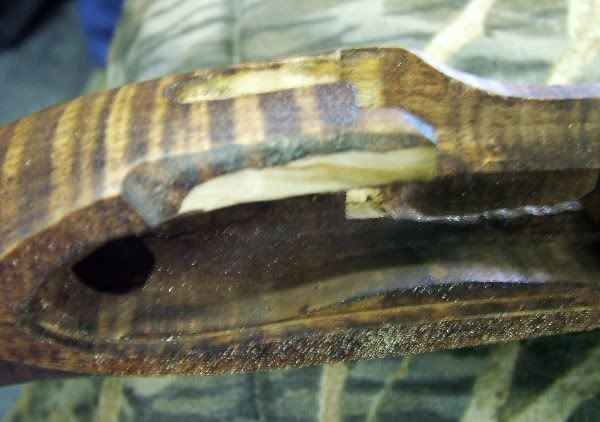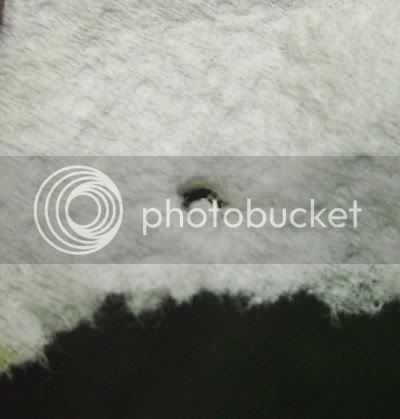The problem with CVA nipples is that they only last a short while. They were cut from soft steel. Replace them with the HotShot nipples from Uncle Mikes( or any supplier. Just call and tell them you need to replace nipples on your CVA, and they will tell you the correct thread size.)
Next, In many of those guns, the face of the hammer, up inside that skirt, DOES NOT strike the top of the nipple evenly. Over time, the force of the hammer blow flattens the high side of the nipple, so the caps no longer sit flush against the top of the nipple, even when you are using the correct size nipple ( I will get to that), and misfires become the rule.
CURE: Take some lipstick, or marking dye, a flow pen, or " magic marker" and coat the top of a NEW nipple installed on the gun. Then gently lower the hammer down so that it rests on the nipple's top edge. The dye will mark the high side in the hammer's face, and not leave any dye on the low. Use a small grinding wheel for a dremel type tool to grind away that high spot. Keep check the high spot by lowering the hammer back down on the nipple to see where the dye is marking your hammerface, and then grind away. Because of close quarters inside that skirt, you can't grind much metal away each time. You will eventually see that the ring of dye on the full nipple will begin to show on the face of your hammer. When you have an even ring the hammer is NOW striking the nipple evenly, and will put pressure on all sides of the cap and nipple to ignite the cap. Now, before you finish, take some paper towels, fold them over to make a couple of layers, place the towels over the nipple, with the lock in your stock, and " fire " the hammer on the empty gun and nipple. You should see what looks like an incomplete paper punch cut, or " donut-hole". The double thickness is how you check that you have in fact created a married surface on that hammer to strike the entire circumference of the nipple. That is how you get 100'% ignition.
Now to the right caps. Now all caps are made equal. I have not had troubles with my CCI caps. However, I am not using European made nipples on my guns, either. I shoot a CVA shotgun, DB, and had two nipples to " fix " before I got reliable ignition, so please, I am speaking from personal experience. I have also helped many of my club members deal with their CVA ignition problems over the years.
The European gun makers don't seem to get it, or don't care. Something is being lost in the translation, or in the exchange rates.
Sometimes the nipples they send over are too long, then some are too short, then others are the right length, but are too small- made to use a #10 cap, instead of the common #11 caps used here. #10 caps are seen in shooting replica revolvers and pistols, BTW. They are a short sided cap, and smaller in diameter, to fit those small nipples found on the 1851 Colt .36, and .44 replica revolvers, and on the smaller .31 pocket pistols. DON'T use these caps on your rifles.
Standard #11 caps work just fine as long as you use an American Made nipple. If you are going to shoot the subs, including Pyrodex, you should consider, and test fire, the #11 magnum caps, which produce more heat, to ignite thse powders reliably. But, if you are shooting Black Powder, The standard cap is all you need. To see how powerful those standard caps are, take you gun into a dark garage, or out in the back yard some night, and fire off a cap on an empty barrel, while watching the muzzle. You will see a flame come out the barrel- no matter how long it is-- that is almost a foot long! The magnum caps don't produce a longer flame, but the flame is often seen as " brighter ". Unless you are shooting " El Crud-O" powder, there is no reason to be using musket caps on a percussion action rifle. Musket caps are married to wider flash channels, nipples with larger hole through them, and large bore smoothbores, and rifles, that shoot large quantities of powder. When watching others shooting musket caps on their standard percussion nipples, what I notice most is the huge flash coming from under the musket cap around the outsides of the nipples, and scorching the lock, barrel, and wood. Musket caps will fire, for sure, but its like driving a cadillac into a garage designed for a pinto: it just doesn't fit.
The great part about fixing your percussion lock, and getting the correct sized nipples for it, is that you only have to do it once, In doing the work, you learn intimately everything about how your lock works, and your confidence in the lock and your gun will increase dramatically.
Try putting an OP wad under that conical you are wanting to shoot. The wad will seal the bore gases for the first and subsequent shots, so you don't have to foul the barrel to get some kind of accuracy. When hunting, run a lubricated patch down the barrel after you seat the maxiball. That will protect the bore of the barrel from rusting, and help keep the fouling soft for subsequent shots. You want to protect that base, or bottom of that slug from being melted, or burned by gases, and you want to prevent gases from blowing by and cutting the sides or " edges " of your bullet or ball. The wad does that, and does it consistently shot after shot. Because the wad will seal the gases so well, you can expect higher velocities, and more complete burning of the powder you shoot. That produces finer residue, which is easier to clean. If the POI changes because of the higher velocity, just reduce the amount of powder you are using to bring the POI back down to where you have the gun zeroed. Simple.
The OP wad should solve most if not all the problems you have experienced with accuracy of that slug in your gun.







